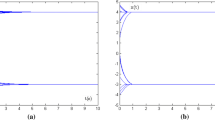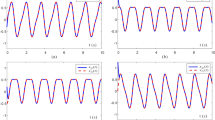Abstract
The time-varying linear equations resolved by the Zeroing neural network (ZNN) models play very important roles in many areas. The traditional ZNN can only achieve the simple finite-time convergence problem, which makes ZNN very easy to be disturbed in the noisy environment. Since the initial state of ZNN is unknown, the finite time convergence depends on its initial state, so the ZNN models activated by the traditional nonlinear activations cannot deal with the different noise interference. To solve the above problems, a novel Power plus Sign activation function (PpSAF) is designed to activate the ZNN model. The predefined-time robust ZNN (PTR-ZNN) model activated by the simple and special nonlinear PpSAF is used to solve the time-variant linear system equations. Through theoretical analysis and simulation comparison of the system expected convergence time and noise tolerance performance, the numerical experiments present that the PTR-ZNN model possesses the predefined-time convergence and strong noise-tolerance performance, and also prove its superiority in solving time-varying linear system equations.










Similar content being viewed by others
References
Li W (2018) A recurrent neural network with explicitly definable convergence time for solving time-variant linear matrix equations. IEEE Trans Ind Inf 14(12):5289–5298
Li W, Ma X, Luo J, Jin L (2021) A strictly predefined-time convergent neural solution to equality- and inequality-constrained time-variant quadratic programming. IEEE Trans Syst Man Cybern 51(7):4028–4039
Li W, Xiao L, Liao B (2020) A finite-time convergent and noise-rejection recurrent neural network and its discretization for dynamic nonlinear equations solving. IEEE Trans Cybern 50(7):3195–3207
Zhang Z, Zheng L, Yang H, Qu X (2019) Design and analysis of a novel integral recurrent neural network for solving time-varying sylvester equation. IEEE Trans Cybern 16(6):1477–1490
Dong L, Zhong X, Sun C, He H (2017) Adaptive event-triggered control based on heuristic dynamic programming for nonlinear discrete-time systems. IEEE Trans Neural Netw Learning Syst 28(7):1594–1605
Chen D, Zhang Y (2018) Robust zeroing neural-dynamics and its time-varying disturbances suppression model applied to mobile robot manipulators. IEEE Trans Neural Netw Learning Syst 29(9):4385–4397
Jin Long, Zhang Yunong, Li Shuai, Zhang Yinyan (2016) Modified ZNN for time-varying quadratic programming with inherent tolerance to noises and its application to kinematic redundancy resolution of robot manipulators. IEEE Trans Ind Ele 63(11):6978–6988
Xiao L (2016) A new design formula exploited for accelerating Zhang neural network and its application to time-varying matrix inversion. Theor Comput Sci 647:50–58
Li S, Liu B, Chen B, Lou Y (2013) Neural network based mobile phone localization using Bluetooth connectivity. Neural Comput Appl 23:667–675
Xiao L (2017) A finite-time convergent Zhang neural network and its application to real-time matrix square root finding. Neural Comput Appl. https://doi.org/10.1007/s00521-017-3010-z
Li S, Cui H, Li Y, Liu B, Lou Y (2013) Decentralized control of collaborative redundant manipulators with partial command coverage via locally connected recurrent neural networks. Neural Comput Appl 23:1051–1060
Li S, Chen S, Liu B (2013) Accelerating a recurrent neural network to finite-time convergence for solving time-varying Sylvester equation by using a sign-bi-power activation function. Neural Process Lett 37:189–205
Xiao L, Zhang Y (2014) From different Zhang functions to various ZNN models accelerated to finite-time convergence for time-varying linear matrix equation. Neural Process Lett 39:309–326
Guo D, Zhang Y (2012) Zhang neural network, Getz-Marsden dynamic system, and discrete-time algorithms for time-varying matrix inversion with application to robots’ kinematic control. Neurocomputing 97:22–32
Li W, Su Z, Tan Z (2019) A variable-gain finite-time convergent recurrent neural network for time-variant quadratic programming with unknown noises endured. IEEE Trans Ind Inf 15(9):5330–5340
Zhang Y, Zhang Y, Chen D, Xiao Z, Yan X (2016) From Davidenko method to Zhang dynamics for nonlinear equation systems solving. IEEE Trans Syst Man Cybern 99:1–14
Jin L, Zhang Y, Qiao T, Tan M, Zhang Y (2016) Tracking control of modified Lorenz nonlinear system using ZG neural dynamics with additive input or mixed inputs. Neurocomputing 196:82–94
Dai J, Jia L, Xiao L (2021) Design and analysis of two prescribed-time and robust ZNN models with application to time-variant Stein matrix equation. IEEE Trans Neural Netw Learning Syst 32(4):1668–1677
Li S, Li Y, Wang Z (2013) A class of finite-time dual neural networks for solving quadratic programming problems and its k-winners-take-all application. Neural Netw 39:27–39
Feng J, Qin S, Shi F, Zhao X (2018) A recurrent neural network with finite-time convergence for convex quadratic bilevel programming problems. Neural Comput Appl 30(11):3399–3408
Tan Z, Hu Y, Xiao L, Chen K (2019) Robustness analysis and robotic application of combined function sctivated RNN for time-varying matrix pseudo inversion. IEEE Access 7:33434–33440
Qiu B, Zhang Y, Yang Z (2018) New discrete-time ZNN models for least-squares solution of dynamic linear equation system with time-varying rank-deficient coefficient. IEEE Trans Neural Netw Learning Syst 29(11):5767–5776
Xiao L, Li K, Duan M (2019) Computing time-varying quadratic optimization with finite-time convergence and noise tolerance: a unified framework for zeroing neural network. IEEE Trans Neural Netw Learning Syst 30(11):3360–3369
Jin L, Li S, Liao B, Zhang Z (2017) Zeroing neural networks: a survey. Neurocomputing 267:597–604
Liu J, Zhang Y, Yu Y, Sun C (2020) Fixed-time leader-follower consensus of networked nonlinear systems via event/self-triggered control. IEEE Trans Neural Netw Learn Syst 31(11):5029–5037
Liu J, Zhang Y, Sun C, Yu Y (2019) Fixed-time consensus of multi-agent systems with input delay and uncertain disturbances via event-triggered control. Inf Sci 480:261–272
Liu J, Yu Y, Sun J, Sun C (2018) Distributed event-triggered fixed-time consensus for leader-follower multiagent systems with nonlinear dynamics and uncertain disturbances. Int J Robust Nonlinear Control 28(11):3543–3559
Liang H, Guo X, Pan Y, Huang T (2021) Event-triggered fuzzy bipartite tracking control for network systems based on distributed reduced-order observers. IEEE Transa Fuzzy Syst 29(6):1601–1614
Liang H, Liu G, Zhang H, Huang T (2020) Neural-network-based event-triggered adaptive control of nonaffine nonlinear multiagent systems with dynamic uncertainties. IEEE Trans Neural Netw Learn Syst 32(5):2239–2250
Liang H, Zhang Y, Huang T, Ma H (2020) Prescribed performance cooperative control for multiagent systems with input quantization. IEEE Trans Cybern 50(5):1810–1819
Yu F, Liu L, Xiao L, Li K, Cai S (2019) A robust and fixed-time zeroing neural dynamics for computing time-variant nonlinear equation using a novel nonlinear activation function. Neurocomputing 350:108–116
Li W, Liao B, Xiao L, Lu R (2019) A recurrent neural network with predefined-time convergence and improved noise tolerance for dynamic matrix square root finding. Neurocomputing 337:262–273
Xu F, Li Z, Nie Z, Shao H, Guo D (2018) Zeroing neural network for solving time-varying linear equation and inequality systems. IEEE Trans Neural Netw Learning Syst 30(8):2346–2357
Li J, Zhang Y, Mao M (2019) General square-pattern discretization formulas via second-order derivative elimination for zeroing neural network illustrated by future optimization. IEEE Trans Neural Netw Learning Syst 30(3):891–901
Tan Z, Li W, Xia L, Hu Y (2020) New varying-parameter ZNN models with finite-time convergence and noise suppression for time-varying matrix moore-penrose inversion. IEEE Trans Neural Netw Learning Syst 31(8):2980–2992
Xiao L, Dai J, Lu R, Li S, Li J, Wang S (2020) Design and comprehensive analysis of a noise-tolerant ZNN model with limited-time convergence for time-dependent nonlinear minimization. IEEE Trans Neural Netw Learning Syst 31(12):5339–5348
Zuo Z, Tie L (2014) A new class of finite-time nonlinear consensus protocols for multi-agent systems. Int J Control 87(2):363–370
Zuo Z, Tie L (2016) Distributed robust finite-time nonlinear consensus protocols for multi-agent systems. Int J Syst Sci 47(6):1366–1375
Xiao L, Zhang Z, Li S (2019) Solving time-varying system of nonlinear equations by finite-time recurrent neural networks with application to motion tracking of robot manipulators. IEEE Trans Syst Man Cybern Syst 49(11):2210–2220
Luo J, Li K, Yang H, Yang J (2020) Comparison on inverse-free method and psuedoinverse method for fault-tolerant planning of redundant manipulator. IEEE Access 8:178796–178804
Xiao L, Tao J, Dai J, Wang Y, Jia L, He Y (2021) A parameter-changing and complex-valued zeroing neural-network for finding solution of time-varying complex linear matrix equations in finite time. IEEE Trans Ind Inform 17(10):6634–6643
Zhang Y, Li Z (2009) Zhang neural network for online solution of time-varying convex quadratic program subject to time-varying linear-equality constraints. Phys Lett A 373(18):1639–1643
Acknowledgements
This work was supported by the National Natural Science Foundation of China (NSFC) under grants (61733005,61673172); by the Science and Technology Research Project in Jiangxi Education Department under grants GJJ207310 and the Teaching Reform Research Topic of Higher Education in Jiangxi province grants JXJG20653.
Author information
Authors and Affiliations
Corresponding author
Additional information
Publisher's Note
Springer Nature remains neutral with regard to jurisdictional claims in published maps and institutional affiliations.
Rights and permissions
About this article
Cite this article
Luo, J., Yang, H. A Robust Zeroing Neural Network Model Activated by the Special Nonlinear Function for Solving Time-Variant Linear System in Predefined-Time. Neural Process Lett 54, 2201–2217 (2022). https://doi.org/10.1007/s11063-021-10726-0
Accepted:
Published:
Issue Date:
DOI: https://doi.org/10.1007/s11063-021-10726-0




